Lysergic acid diethylamide (LSD), commonly known as Acid, is a potent psychedelic substance. Its consumption leads to heightened thoughts, emotions, and sensory perceptions. At sufficiently high doses, LSD primarily triggers mental, visual, and auditory hallucinations. According to the Substance Abuse and Mental Health Services Administration (SAMHSA) about 5.6 million people aged 12 and older in the United States had used LSD at least once in their lifetime.
The effects of LSD range from profound euphoria and feelings of interconnectedness to intense anxiety, confusion, or paranoia. Changes in perception of time and space are common, with minutes feeling like hours or an altered sense of body size. Physiological effects include increased heart rate, dilated pupils, and changes in body temperature.
LSD addiction poses various risks, including physical health deterioration due to prolonged use and potential overdose. Psychological risks include increased anxiety and paranoia. Socially, addiction to LSD will strain relationships, lead to social isolation, and contribute to legal issues if the drug is obtained or used illegally.
Recovery from LSD addiction is possible with dedication and support. Seeking professional help, such as therapy and counseling, aids in addressing underlying issues contributing to addiction. Building a strong support network of friends, family, and peers who understand and encourage recovery efforts will also be immensely beneficial.
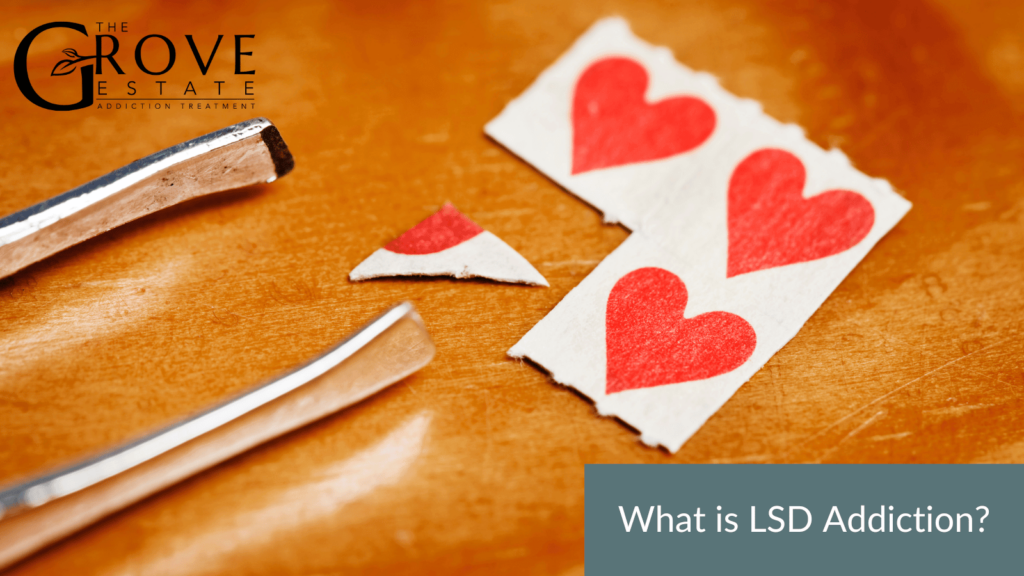
What is LSD Addiction?
LSD (Lysergic Acid Diethylamide) addiction is a destructive and compulsive misuse of the substance. According to a study by the National Institute on Drug Abuse (NIDA), while LSD is not physically addictive like opioid drugs, it can lead to mental, emotional, and behavioral dependence in some individuals. This addiction can manifest as a craving for the unique experiences, sensations, and insights induced by LSD, potentially leading to harmful patterns of use.
Public perception towards LSD has indeed shifted, especially regarding the practice of microdosing. A study published in the Journal of Psychoactive Drugs found that among individuals who reported using LSD, 74.5% reported experiencing positive psychological effects such as increased feelings of interconnectedness, insightfulness, and a sense of wonder. This suggests that while LSD can have risks, some users perceive positive benefits from its effects.
While LSD is considered non-addictive with a low risk of overdose and no known cases of fatal overdose, long-term and frequent use can still result in addiction. A report by the Substance Abuse and Mental Health Services Administration (SAMHSA) shows that chronic LSD use can lead to tolerance, where individuals need increasing doses to achieve the desired effects, further enhancing the risk of addiction.
LSD, chemically synthesized from lysergic acid derived from the ergot fungus, undergoes intricate laboratory processes during production. These processes are typically carried out in clandestine laboratories or illicit settings by individuals with knowledge of chemistry and access to precursor chemicals. The Drug Enforcement Administration (DEA) reports that the production of LSD involves precise modifications of lysergic acid and its combination with other substances to create potent forms of the drug, often distributed in the form of small squares of absorbent paper.
What Happens When You Take LSD?
When the effects of LSD fully set in, you encounter a spectrum of experiences, encompassing both favorable and adverse effects:
- Feelings of Euphoria
- Moments of Anxiety
- Vivid Hallucinations
- Increased Heart Rate
- Impaired Decision-Making Abilities
- Fluctuations in Mood
Having a “good trip” typically denotes a positive encounter, whereas a “bad trip” can entail feelings of anxiety and paranoia.
How Long After Taking LSD Will You Feel the Effects?

When LSD is consumed it initiates a journey commonly referred to as “tripping.” The time it takes for the effects to begin and the duration of the trip can vary depending on several factors, such as age, dosage, metabolism, and liver health.
| Method of Administration | Onset of Effects | Peak Experience Time | Duration of Trip |
| Oral Dose (100-250 micrograms) | 30-45 minutes post-ingestion | 1 to 2.5 hours after onset | 9-12 hours |
| Intramuscular Injection (100-250 micrograms) | As little as 15 minutes | Within the first hour | 9-10 hours |
| Intravenous Injection (40-180 micrograms) | Almost immediate | Around 1 hour after onset | 9-10 hours |
| Intraspinal Dose (20-60 micrograms) | Within an hour after ingestion | Soon after peak | 9-10 hours |
What Risks are Associated with LSD Addiction?
The consequences of addiction to LSD can mirror those of more potent substances, albeit LSD tends to have slightly lower damaging effects. Prolonged and excessive use of LSD leads to various physical, psychological, and emotional difficulties. Here’s an overview of the risks associated with LSD addiction:
Physical risks:
- Potential harm to organs
- Impaired coordination and motor skills
- Disrupted sleep patterns
- Nutritional deficiencies
- Increased likelihood of accidents or injuries
Psychological effects:
- Psychosis or hallucinogen persisting perception disorder (HPPD)
- Anxiety disorders
- Mood swings and emotional volatility
- Cognitive impairments
- Paranoia or delusional thinking
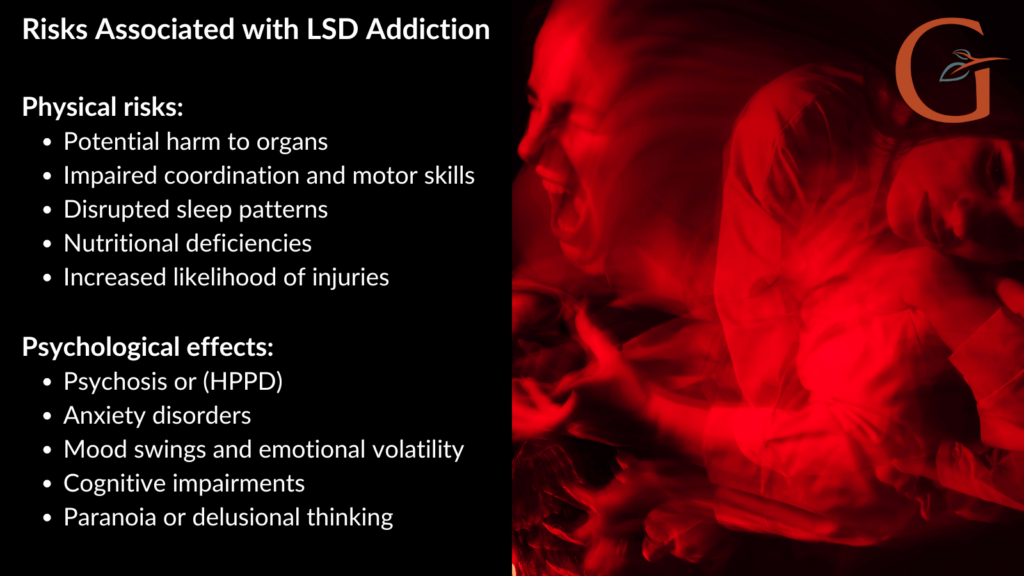
What Factors Contribute to LSD Addiction?
The development of LSD addiction can stem from a combination of factors unique to each person. Here are several factors that cause LSD addiction:
- Curiosity and experimentation: Some individuals try LSD out of curiosity or a desire for new experiences, which can progress to dependence and addiction with continued use.
- Traumatic experiences: Events like abuse, neglect, or significant life changes can contribute to addiction as a means to escape or numb emotional distress.
- Underlying mental health issues: Pre-existing conditions like depression, anxiety, or trauma-related disorders can make individuals more prone to seeking relief or escape through drug use, including LSD.
- Peer pressure and social environment: Influence from friends, social circles, or environments where drug use is prevalent can impact decisions to experiment with LSD and potentially lead to addiction.
- Genetic predisposition: A genetic vulnerability could increase the likelihood of developing an addiction. Family history, especially with substance abuse, may influence susceptibility.
- Coping mechanisms and self-medication: LSD may be used as a coping mechanism for stress, emotional pain, or as a form of self-medication for underlying psychological struggles, creating a cycle of dependence.

How Does LSD Work and Why is it Addictive?
LSD is a psychedelic substance that interacts with specific receptors, particularly those in the serotonin system. This interaction leads to a surge in serotonin levels, resulting in heightened sensory experiences, altered perception, and hallucinations.
The allure of LSD’s addictive nature lies in its profound psychological effects. It can induce euphoria, a sense of expanded consciousness, and distortions of time and reality that many find captivating and pleasurable, prompting a desire for repeated use.
Additionally, LSD consumption can disrupt normal neurotransmitter function and neural circuits in the brain. Continued use may alter the brain’s reward system, leading to cravings for the drug to experience pleasure or escape reality. This can lead to tolerance, where larger doses are needed over time, and withdrawal symptoms upon cessation.
What are Recovery Options for LSD Addiction?
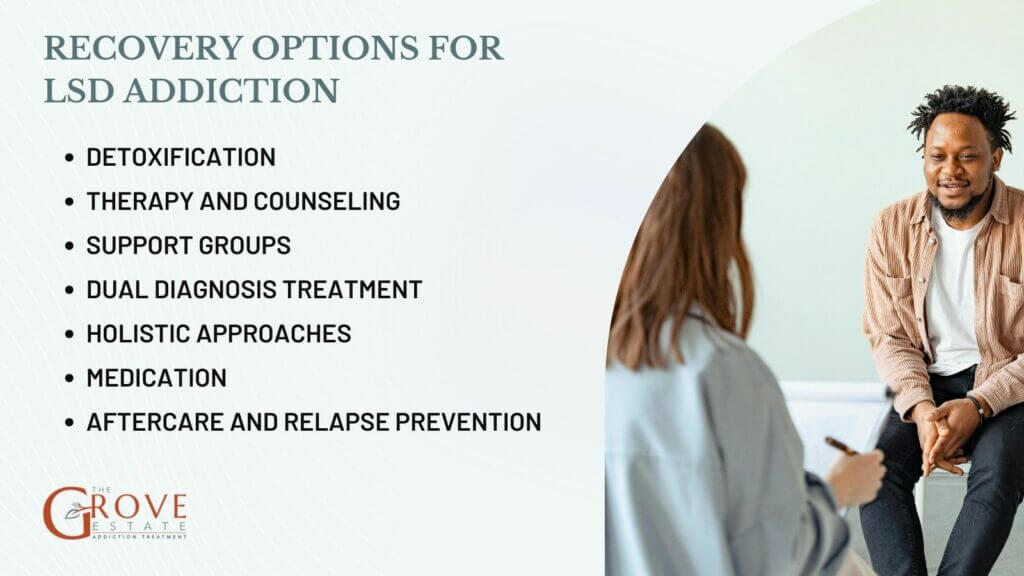
If you or a loved one are struggling with LSD misuse and aim to effectively address its effects and achieve sobriety, a comprehensive treatment approach may be necessary. Here are 7 treatment options that aid in recovery:
- Detoxification: Though LSD doesn’t cause physical dependence, a supervised detox can help manage any lingering psychological effects or withdrawal symptoms.
- Therapy and Counseling: Engage in behavioral therapies like cognitive-behavioral therapy (CBT) or motivational interviewing, either individually or in groups, to tackle root causes, develop coping skills, and prevent relapse.
- Support Groups: Join support communities like Narcotics Anonymous (NA) for ongoing understanding, encouragement, and solidarity with others on similar journeys.
- Dual Diagnosis Treatment: If there are concurrent mental health issues, seek integrated treatment that addresses both conditions simultaneously.
- Holistic Approaches: Incorporate holistic practices such as meditation, mindfulness, art therapy, or yoga to enhance overall well-being and manage stress.
- Medication: While no specific drug treats LSD addiction, medications will help manage co-occurring mental health issues or alleviate withdrawal symptoms.
- Aftercare and Relapse Prevention: Develop an aftercare plan with ongoing support, relapse prevention strategies, and regular follow-ups with healthcare professionals.
Are There Withdrawal Symptoms from LSD Addiction?
LSD (acid) differs from substances like opioids or alcohol as it doesn’t cause severe physical withdrawal symptoms. However, stopping LSD after extended use does lead to psychological and emotional effects often termed a “comedown” or “afterglow.”
These effects are primarily psychological and emotional, varying in intensity among individuals. Here are some the withdrawal symptoms associated with LSD cessation:
- Flashbacks: Intermittent re-experiences of LSD-induced sensory distortions, known as “flashbacks” or HPPD, can occur during withdrawal or even later.
- Fatigue: Feelings of tiredness or low energy levels.
- Mood swings: Fluctuations from euphoria to irritability, anxiety, or depression.
- Psychological distress: Anxiety, restlessness, or emotional discomfort may arise.
While these symptoms are temporary and lessen over time, seeking support from an addiction therapist can aid in a comprehensive recovery journey.
What is the “Comedown” or the “Afterglow”?
The “comedown” or “afterglow” following LSD use refers to the period of time after the peak effects of the drug have subsided. During this phase, users may experience a range of psychological and emotional effects as the drug’s influence diminishes. The term “comedown” denotes a phase characterized by a gradual return to baseline mental and physical states after the intense effects of LSD have worn off. On the other hand, the term “afterglow” is used to describe a more positive or pleasant state that users experience after the peak effects of LSD, characterized by feelings of relaxation, enhanced mood, and introspection. It’s important to note that individual experiences during the comedown or afterglow phase vary widely based on factors such as dosage, set and setting, and personal disposition.
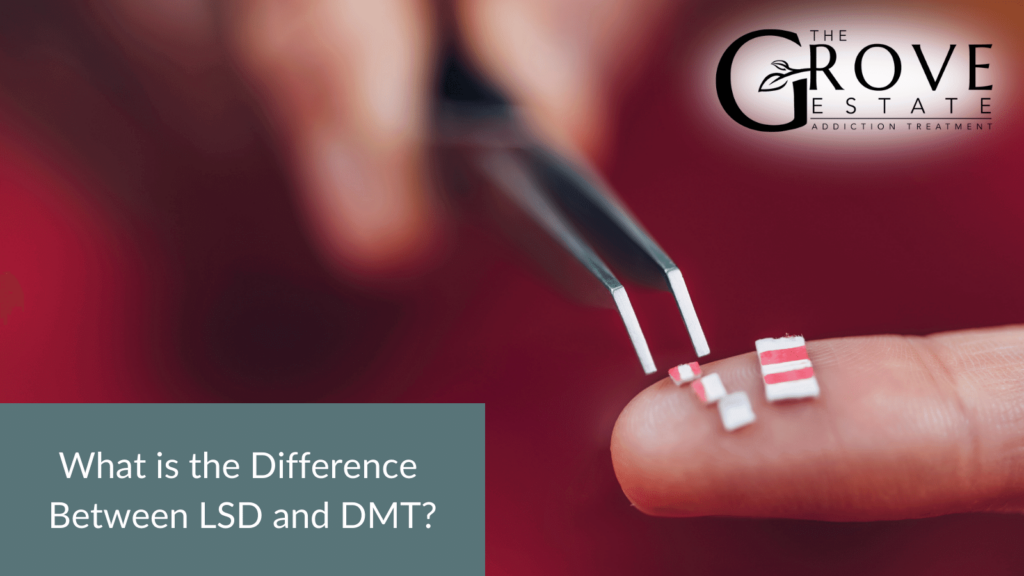
What is the Difference Between LSD and DMT?
LSD (lysergic acid diethylamide) and DMT (dimethyltryptamine) are both potent psychedelics with distinct chemical structures, effects, and physical forms. LSD, a semi-synthetic substance derived from ergot fungus, is found in liquid form or soaked into blotter papers and produces long-lasting psychoactive effects, often including visual hallucinations and altered time perception. DMT, naturally occurring in certain plants, appears as a crystalline powder and is known for its rapid, intense effects, which include vivid visual experiences and potential encounters with entities.
While LSD effects can last up to 12 hours, DMT’s effects are shorter, lasting about 30 minutes when smoked. The experiences they produce also differ: LSD creates a more introspective and emotionally rich journey, often described as expanding one’s consciousness and perception of reality, while DMT is known for its rapid and immersive “breakthrough” experiences, often characterized by intense visuals and encounters with otherworldly entities.
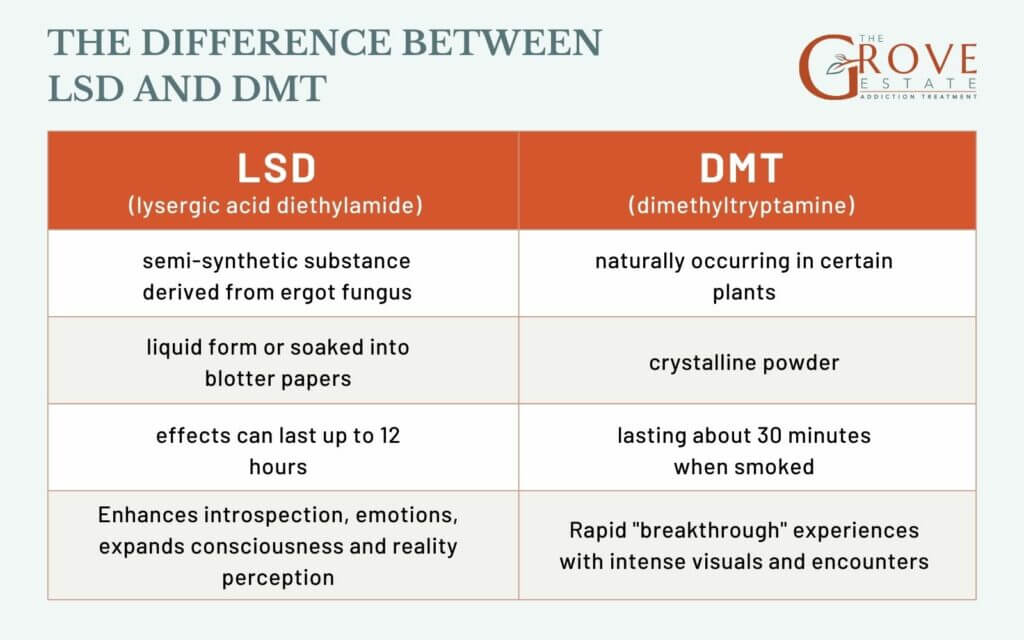
What are other names for LSD?
LSD is commonly referred to as acid, dots, blotter, and Lucy. These nicknames reflect the various forms in which the drug is consumed and its cultural impact over the years.
How long does LSD detox last?
LSD detox primarily involves psychological symptoms which can last for a few days. Unlike substances that cause physical dependence, LSD does not typically produce prolonged physical withdrawal symptoms.
What ways do people consume acid?
People consume LSD in several ways, including blotter paper (small squares soaked in LSD), liquid drops (often placed on the tongue or sugarcubes), gelatin squares, and microdots (tiny pills).
What is a “Bad Trip”?
A “bad trip” on LSD refers to an experience that is intensely distressing or frightening for the user, marked by unpleasant or scary hallucinations, anxiety, paranoia, and a feeling of losing control. Factors contributing to a bad trip includes the user’s mental state before taking the drug, the environment in which the drug is used, and unexpected interactions with the substance. Bad trips can be psychologically unsettling and may have lasting impacts on an individual’s mental health.
What are the psychological effects of LSD compared to other psychedelics?
LSD, known for its profound impact on perception and consciousness, often induces intense visual and auditory hallucinations, altered sense of time, and emotional experiences that can range from euphoria to deep existential dread. According to the National Institute on Drug Abuse, these effects are primarily due to LSD’s interaction with serotonin receptors, which significantly alters brain communication temporarily.
In contrast to Peyote addiction, which involves the psychedelic mescaline, LSD typically produces a longer-lasting experience with more profound cognitive and visual alterations. While both substances can lead to psychological dependency, the nature of the dependency and the user’s experiences differ significantly, reflecting the unique properties of each psychedelic compound.
How do social and environmental factors influence LSD addiction?
Social and environmental factors play a crucial role in the risk and development of LSD addiction. Settings that encourage or normalize drug use can significantly increase the likelihood of experimenting with LSD, potentially leading to repetitive use and psychological dependency. According to the National Institute on Drug Abuse, the influence of peers, the availability of drugs, and the presence of stressors or lack of support can all contribute to substance use disorders.
Recovery environments, such as an aftercare facility, are critical in supporting individuals recovering from LSD addiction. These facilities provide a structured and supportive environment where individuals can continue to recover through ongoing therapy, support groups, and relapse prevention strategies, further illustrating the importance of positive social and environmental factors in successful addiction recovery.

Share This Post



